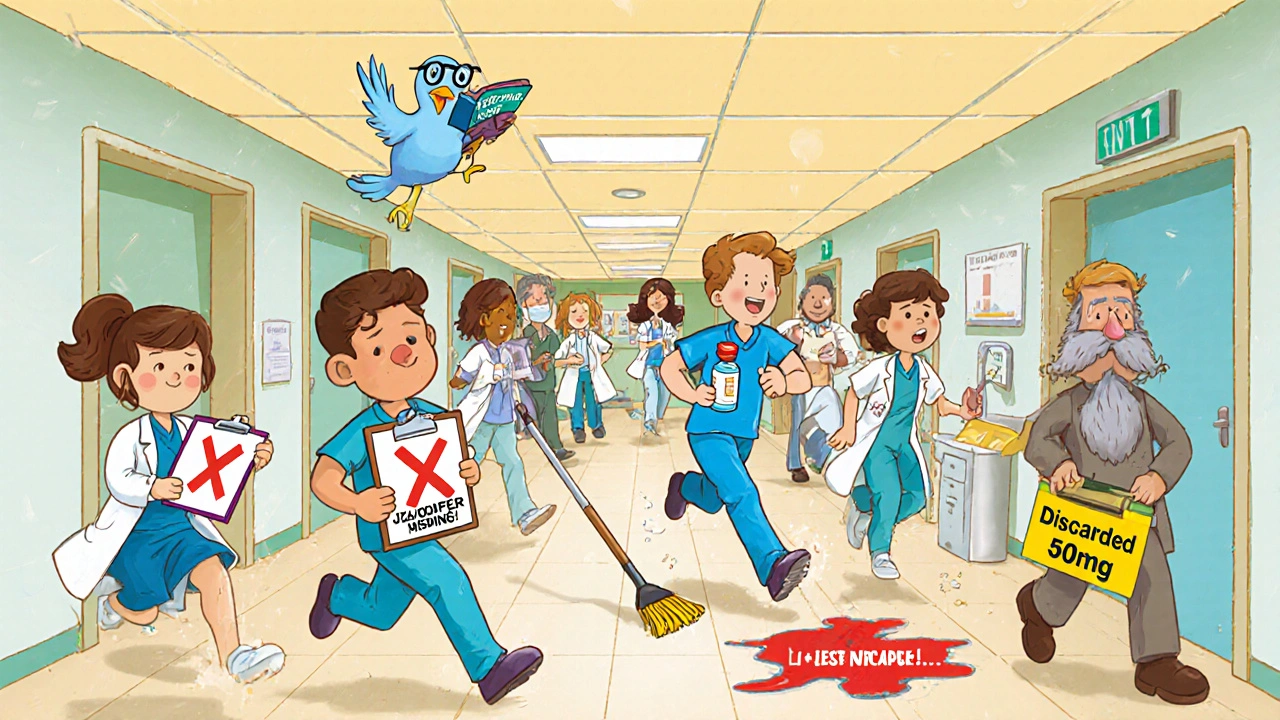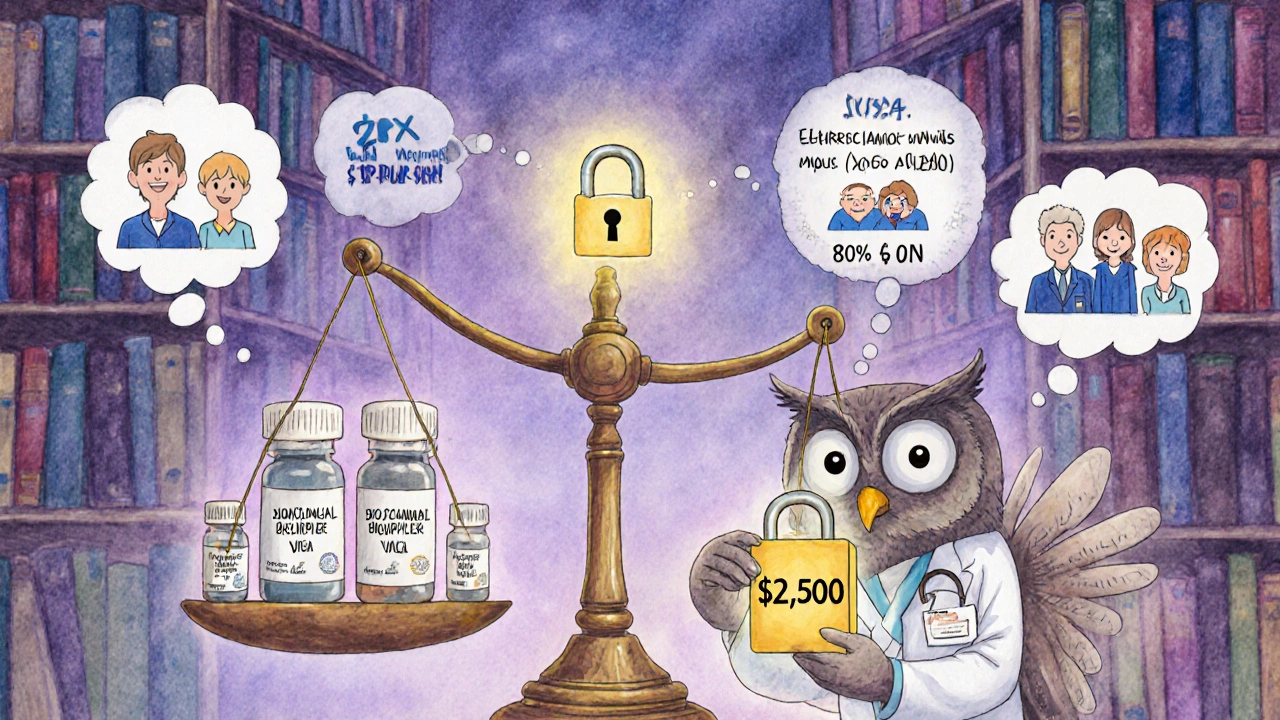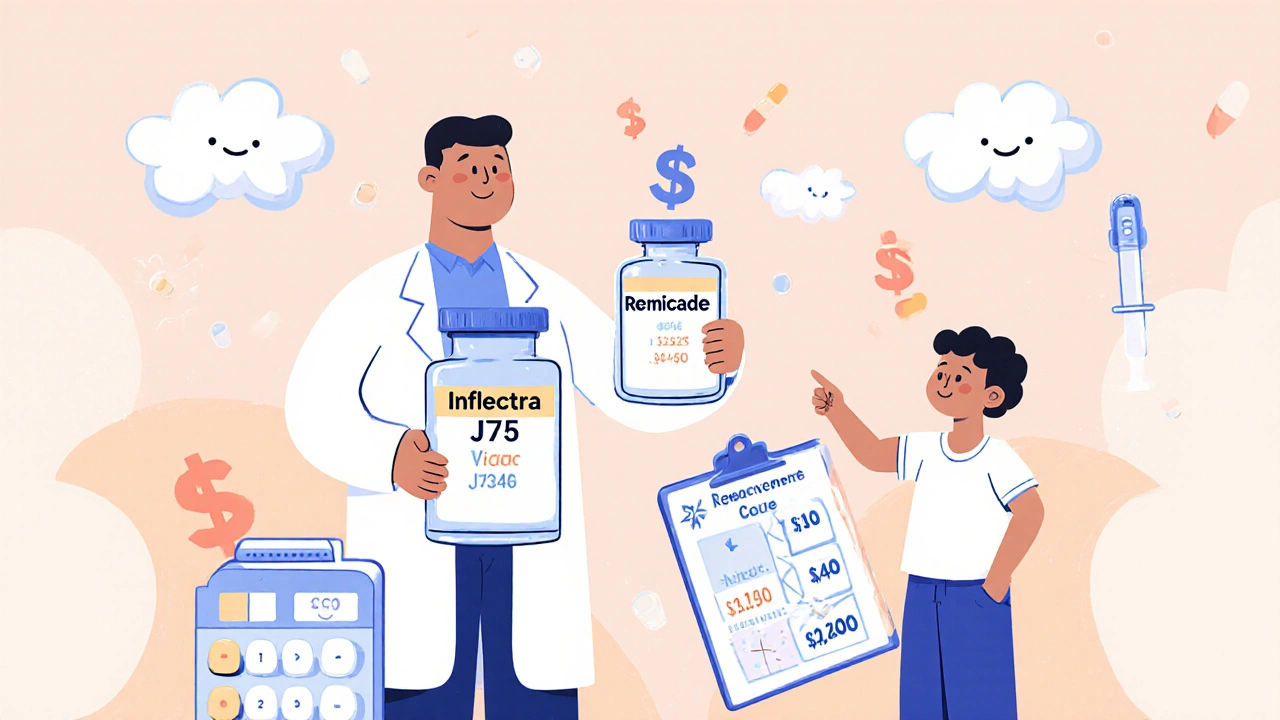When a patient gets a biosimilar drug like Inflectra or Renflexis instead of Remicade, the billing process isn’t as simple as switching one pill for another. Unlike generic pills, which are chemically identical to their brand-name versions, biosimilars are complex biological products made from living cells. That complexity changes how they’re coded, billed, and paid for-especially under Medicare Part B. If you’re a provider, pharmacist, or even a patient trying to understand why your bill looks different, this is how it actually works.
How Biosimilars Are Coded Differently Than Generics
Generic drugs use the same HCPCS code as their brand-name counterparts. If you prescribe a generic lisinopril, you bill it under the same code as the brand-name Zestril. But biosimilars? Each one gets its own unique code. That’s because the FDA treats them as distinct products, even if they’re highly similar to the original biologic. After FDA approval, each biosimilar is assigned a temporary Q-code or permanent J-code. For example:- Inflectra (infliximab biosimilar) → J1745
- Renflexis (infliximab biosimilar) → J1747
- Remicade (reference product) → J1740
How Medicare Pays for Biosimilars
Medicare Part B pays for most biologics and biosimilars at 106% of the average sales price (ASP). But here’s the twist: the 6% add-on is calculated differently for biosimilars versus the reference product. For a biosimilar, Medicare pays:- 100% of the biosimilar’s own ASP
- Plus 6% of the reference product’s ASP
- Remicade: $2,500 + 6% of $2,500 = $2,650
- Inflectra: $2,000 + 6% of $2,500 = $2,150
Why This Payment Model Slows Adoption
You’d think lower-priced biosimilars would quickly replace expensive biologics. But in the U.S., biosimilar adoption for infliximab is only about 35% after five years. In Europe, it’s 75-80%. Why the gap? The 6% add-on tied to the reference product’s price creates a financial disincentive. Providers earn more per dose by sticking with the brand. A 2020 analysis by Dr. Mark Trusheim at MIT found that for every dose of Remicade administered, providers make $30 more than with Inflectra. That’s not a small difference when you’re treating hundreds of patients a month. Even when biosimilars are 20-30% cheaper, the reimbursement gap is often only 10-15%. That’s not enough to change prescribing habits, especially in oncology or rheumatology practices where biologics are routine. A 2022 survey of 217 cancer centers found that despite cost savings, providers still chose the reference product 70% of the time.
The JZ Modifier: A New Layer of Complexity
On July 1, 2023, CMS added a new requirement: the JZ modifier. This modifier must be added to claims for infliximab and its biosimilars when no drug is discarded during administration. Why? Because Medicare only pays for the amount actually used. If a 100mg vial is given to a patient who only needs 50mg, the provider can bill for the full 100mg only if they document the unused portion was discarded. But if they use every drop? They must use the JZ modifier to prove no waste occurred. This sounds simple, but it’s created real headaches. One gastroenterology practice reported a 30% increase in billing staff time just to track discarded amounts. If the modifier is missing, claims get denied. And since many providers didn’t know about it until after it went live, claim denials spiked in the first quarter of 2024.What Providers Get Wrong-and How to Avoid It
Most billing errors come from three sources:- Using the wrong HCPCS code (e.g., billing Inflectra as J1740 instead of J1745)
- Forgetting the JZ modifier for infliximab products
- Using outdated ASP rates from last quarter’s CMS update
- Pharmacy staff confirm the exact biosimilar administered
- Billing staff cross-check the code and modifier against CMS’s latest Drug Pricing File

How Payment Differs Across Payers
Medicare Part B isn’t the only payer. Medicare Advantage plans, commercial insurers, and Medicaid all have their own rules.- Medicare Part B: 106% of ASP (biosimilar’s ASP + 6% of reference’s ASP)
- Medicare Advantage: Often 100-103% of ASP-sometimes without the 6% add-on
- Commercial insurers: Vary wildly. Some pay 100% of WAC, others use formulary tiers that favor biosimilars
- Medicaid: Usually follows Medicare, but state-specific rules apply
What’s Next? Changes Coming by 2025
Critics say the current system is broken. The 6% add-on tied to the reference product’s price doesn’t encourage savings-it rewards cost. That’s why MedPAC (Medicare Payment Advisory Commission) recommended a major shift: consolidated billing. Under this proposal, all biosimilars and the reference product for a given drug class would share one payment rate: 106% of the volume-weighted average ASP. So if 60% of infliximab doses given are Inflectra at $2,000 and 40% are Remicade at $2,500, the payment would be based on $2,200-not $2,500. CMS is considering this change. In February 2023, they issued a notice asking for public feedback. If adopted by 2025, it could push U.S. biosimilar adoption from 35% to 65%-matching European levels. Another idea: eliminate the reference product’s ASP from the biosimilar’s add-on. That would mean Inflectra gets paid 106% of its own ASP ($2,120), not $2,150. That small change could boost utilization by 15-20 percentage points, according to Avalere Health.The Bottom Line
Biosimilars aren’t generics. Their billing system was built for complexity-and it’s still evolving. The current model tracks usage well but fails to reward cost savings. Providers are stuck between clinical guidelines and financial incentives that don’t align. Patients pay more than they should. And the system, as it stands, doesn’t fully deliver on the promise of affordable biologics. But change is coming. With CMS actively reviewing payment models and manufacturers pushing for simpler billing, the next two years could redefine how biosimilars are paid for in the U.S. For now, the best move for providers? Know your codes, verify your modifiers, and always check the latest ASP rates. Because in biosimilar billing, the smallest error can mean the biggest loss.Do biosimilars use the same HCPCS code as the reference biologic?
No. Each biosimilar has its own unique HCPCS code-either a Q-code (temporary) or J-code (permanent). For example, Remicade is J1740, while Inflectra is J1745. This is different from generics, which share the same code as the brand-name drug. The separate codes allow Medicare to track each biosimilar’s usage and payment individually.
Why do providers get paid more for the reference biologic than the biosimilar?
Because Medicare calculates the 6% add-on based on the reference product’s ASP, not the biosimilar’s. So even if a biosimilar costs 25% less, the provider still gets 6% of the higher-priced reference drug’s cost added to their payment. For example, if Remicade costs $2,500 and Inflectra costs $2,000, the provider gets $150 more per dose with Remicade. This structure reduces the financial incentive to switch.
What is the JZ modifier and when do I need to use it?
The JZ modifier is required on claims for infliximab and its biosimilars when no drug is discarded during administration. It tells Medicare that the entire vial was used. If you open a 100mg vial and give 90mg, you must use the JZ modifier to claim payment for the full 100mg. If you discard any amount, you bill only for what was used and don’t use the modifier. This rule went into effect July 1, 2023, and missing it causes claim denials.
How often are biosimilar payment rates updated?
CMS updates biosimilar payment rates quarterly, based on the most recent Average Sales Price (ASP) data. The updates typically take effect on January 1, April 1, July 1, and October 1. Providers must check the official CMS Drug Pricing File each quarter to ensure they’re using the correct codes and rates. Using outdated data is one of the top reasons for claim denials.
Are biosimilars covered the same way by Medicare Advantage and commercial insurers?
No. Medicare Advantage plans often pay 100-103% of ASP and may not include the 6% add-on. Commercial insurers vary widely-some have formularies that favor biosimilars, others reimburse based on wholesale cost or negotiate private contracts. Medicaid usually follows Medicare but can have state-specific rules. Always verify coverage with each payer before prescribing.
Will biosimilar adoption increase in the U.S. soon?
It depends on policy changes. Under the current system, adoption is stuck around 35% for mature products. But if CMS adopts a consolidated billing model-paying 106% of the weighted average ASP across all products-adoption could jump to 65-70% by 2027. Experts agree that without reforming the 6% add-on structure, adoption will plateau near 40-45%.






9 Comments
This whole system is a joke. Biosimilars are cheaper, safer, and just as effective-but we’re literally paying providers to keep using the expensive version? The 6% add-on is a corporate handout disguised as policy. Someone’s getting rich while patients bleed out from co-pays. And don’t get me started on the JZ modifier-like, why are we making nurses into pharmacists and coders? This isn’t healthcare, it’s accounting theater with IV drips.
Also, why does every country outside the US figure this out but we still think ‘brand loyalty’ applies to life-saving drugs? We’re not buying sneakers here.
Also also: if you’re a provider and you’re still prescribing Remicade over Inflectra because of reimbursement, you’re not a healer-you’re a revenue optimizer. Sad.
PS: I work in pharma billing. We’ve seen this mess up 37 claims in one week. No one wins.
OMG YES THIS IS SO IMPORTANT 🙌 I’ve been a rheumatology nurse for 12 years and this is the first time I’ve seen a post that actually explains the billing chaos in a way that makes sense. The JZ modifier? Total nightmare. We had to retrain the whole team in 2 weeks. My coworker cried because she missed it on a claim and got denied $18k in revenue 😭
But here’s the good news-our clinic started using Fresenius Kabi’s free coding guide last month and our denials dropped from 14% to 2%. Like, 2%! And we’re finally able to push biosimilars without feeling guilty about losing money. Providers need to stop treating this like a mystery box and just use the damn resources. Also, thank you for mentioning the ASP updates-so many people forget to check quarterly and then wonder why claims get rejected. You’re a lifesaver 💙
Stop making this harder than it needs to be. If the biosimilar costs less use it. End of story. The system is broken because people are lazy and scared of change. You don’t need a 10-page guide to know that J1745 is not J1740. You don’t need a PhD to understand that 6% of a higher price is a financial incentive to not save money. This isn’t rocket science. It’s basic math and ethics. If you’re a provider and you’re choosing the more expensive drug because of reimbursement you’re not just bad at billing-you’re bad at medicine. Fix the coding. Use the modifier. Check the ASP. Do your job. Patients are waiting.
Okay so let me get this straight-big pharma pays the government to make sure biosimilars can’t compete? The 6% add-on isn’t a mistake. It’s a contract. You think CMS just woke up one day and went ‘hmm what if we reward doctors for using expensive drugs’? Nah. This is all orchestrated. The same people who own Remicade also own the lobbyists who wrote this billing code. The JZ modifier? That’s just to keep small clinics drowning in paperwork so they give up and stick with the brand. And don’t even get me started on the ‘free coding guides’-those are just Trojan horses to lock you into their ecosystem. Wake up people. This isn’t healthcare. It’s a rigged casino with syringes.
It’s ironic, isn’t it? We’ve created a system that incentivizes the preservation of cost rather than the promotion of care. We treat medicine like a commodity, but it’s not-it’s a human act. And yet we’ve layered on bureaucratic abstractions-codes, modifiers, ASP differentials-that turn healing into a spreadsheet game. Who decided that a drug’s value should be measured not by its effect on a patient’s life, but by its price relative to another drug’s price? We’ve lost the soul of medicine to the algorithm. The biosimilar isn’t the problem. The system is. And until we stop valuing profit over presence, we’ll keep pretending innovation is happening while the real work-care-stagnates.
Also, why do we still call it ‘reimbursement’? It sounds so clean. Like we’re returning something that was lost. But we’re not. We’re paying for privilege.
Man I’ve been sitting here reading this and I just keep thinking about my cousin who’s on infliximab. She’s 29. Has Crohn’s. Got insurance but still pays $400 a shot for Remicade. Last month she switched to Inflectra after her doc finally pushed for it-cost her $80. That’s 80% less. But I bet her doctor didn’t get paid the same. That’s messed up. Like, we’re asking people to choose between their health and their provider’s paycheck? That’s not a system. That’s a trap.
And the JZ modifier? I get it. No waste. But if you’re using a 100mg vial on a 50mg patient and you’re not discarding anything? You’re either a miracle worker or you’re lying. And if you’re lying, you’re not saving money-you’re gaming the system. So why are we punishing the honest ones? This whole thing feels like a game of hot potato with someone else’s life.
Also-why is the US the only country that treats medicine like a stock market? Europe just says ‘use the cheaper one’ and moves on. We overthink everything until it breaks.
Why even bother? They’ll never change it. Same as always. Pharma wins. Patients lose. Provider gets confused. JZ modifier? LOL. Just bill it like before and hope no one notices. I’ve been doing this for 8 years. Nothing changes. Just more paperwork. More stress. More denials. I’m just gonna keep using Remicade. It’s easier. And hey, my bonus depends on it. 🤷♂️
This post reads like a corporate pamphlet dressed up as journalism. Biosimilars are inferior by design. They’re not generics-they’re ‘close enough’ drugs made by companies that can’t replicate the original’s purity. The FDA approves them because it’s cheaper than demanding full clinical trials. The reimbursement model? It’s not broken-it’s protecting patients from substandard alternatives. You think Europe’s 80% adoption is a win? They’re sacrificing quality for cost. And now you want to copy that? Don’t be naive. The 6% add-on exists because the reference product has decades of safety data. Biosimilars? Still being monitored. Wake up. This isn’t about money. It’s about survival.
I work in billing and I can confirm the JZ modifier is a nightmare. We had 23 claims get denied in one week because someone forgot it. But honestly? The real issue is that CMS updates the ASP every quarter and no one checks. I saw a provider bill using 2022 rates in March 2024. Like bro. You’re literally throwing away money. Also-stop using the same code for every infliximab. J1740 is for Remicade only. Inflectra is J1745. It’s not hard. If you can’t get this right you shouldn’t be handling biologics. And yes I know this sounds harsh but I’ve seen patients wait weeks because of coding errors. This isn’t theoretical. People suffer when we mess up.